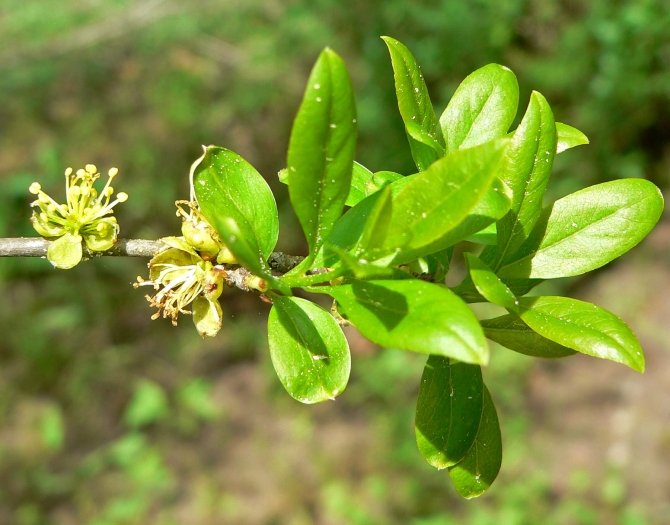Stretchberry
(Forestiera pubescens)
Stretchberry (Forestiera pubescens)
/
/

Stan Shebs
CC BY-SA 3.0
Image By:
Stan Shebs
Recorded By:
Copyright:
CC BY-SA 3.0
Copyright Notice:
Photo by: Stan Shebs | License Type: CC BY-SA 3.0 | License URL: https://creativecommons.org/licenses/by-sa/3.0 | Uploader: Stan Shebs | Publisher: Wikimedia Commons | Title: Forestiera_pubescens_2.jpg | Notes: Photographed by and copyright of (c) David Corby ([[User:Miskatonic]], uploader) 2006 Image of an Ocotillo Flower taken in Anza Borrego |






























































Estimated Native Range
Summary
Forestiera pubescens, commonly known as Stretchberry or New Mexico Privet, is a deciduous shrub or small tree native to the arid and semi-arid regions, including desert scrub, riparian woodlands, and pinyon-juniper woodlands of the Southwestern United States, California, and Northern Mexico. It typically grows to a height of 6 feet and can spread 3-7 feet wide. This plant is adaptable to a range of environmental conditions within its native range, which contributes to its resilience in cultivation.
Stretchberry is valued for its early spring yellow flowers, which are small but numerous, and its ability to attract pollinators. It is often used in naturalistic plantings, as a screen or hedge, and in restoration projects due to its hardiness and low maintenance requirements. It thrives in full sun to part shade and prefers medium amounts of water, though it is drought-tolerant once established. Suitable for soils with medium to fast drainage, it is a versatile choice for gardeners in arid climates. While generally disease-free, it can occasionally suffer from root rot in poorly drained soils. Stretchberry is also appreciated for its wildlife value, providing food and habitat for birds and other fauna.CC BY-SA 4.0
Stretchberry is valued for its early spring yellow flowers, which are small but numerous, and its ability to attract pollinators. It is often used in naturalistic plantings, as a screen or hedge, and in restoration projects due to its hardiness and low maintenance requirements. It thrives in full sun to part shade and prefers medium amounts of water, though it is drought-tolerant once established. Suitable for soils with medium to fast drainage, it is a versatile choice for gardeners in arid climates. While generally disease-free, it can occasionally suffer from root rot in poorly drained soils. Stretchberry is also appreciated for its wildlife value, providing food and habitat for birds and other fauna.CC BY-SA 4.0
Plant Description
- Plant Type: Shrub
- Height: 5-10 feet
- Width: 3-7 feet
- Growth Rate: Moderate
- Flower Color: N/A
- Flowering Season: Spring
- Leaf Retention: Deciduous
Growth Requirements
- Sun: Full Sun, Part Shade
- Water: Medium
- Drainage: Medium, Fast
Common Uses
Bee Garden, Bird Garden, Butterfly Garden, Deer Resistant, Drought Tolerant, Fire Resistant, Low Maintenance
Natural Habitat
native to the arid and semi-arid regions, including desert scrub, riparian woodlands, and pinyon-juniper woodlands of the Southwestern United States, California, and Northern Mexico
Other Names
Common Names: Desert Olive, Tanglewood, Devil’s Elbow, Spring Goldenglow, Spring Herald, New Mexico Privet, Texas Forsythia
Scientific Names: , Forestiera pubescens, Adelia pubescens, Forestiera ligustrina var. pubescens,
GBIF Accepted Name: Forestiera pubescens Nutt.